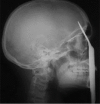Trans-orbital orbitocranial penetrating injury by pointed iron rod
- PMID: 25883487
- PMCID: PMC4387818
- DOI: 10.4103/0976-3147.150282
Trans-orbital orbitocranial penetrating injury by pointed iron rod
Abstract
Trans-orbital orbitocranial penetrating injury (TOPI) by a foreign body is an extremely rare compound head injury having a potential to cause major morbidity and mortality. Preoperative radiological imaging by CT scan is very important for operative guidance, but in remote area where CT scan is not available, the patient is generally referred to tertiary level. Here we present a case which was dealt successfully without CT scan, only on the basis of stable clinical status and X-rays. We present a case of a 35-year-old man who had an accidental injury (fall from height) by rod. Immediate X-ray (anteroposterior and lateral views) revealed that the pointed end of the foreign body (rod) was inside the ipsilateral anterior fossa via basifrontal bone up to frontal vertex, not crossing the midline. CT scan was not available and his vitals with GCS were normal (15/15). He was operated with the help of an ophthalmic surgeon by right frontotemporal craniotomy. The patient was discharged on 10(th) day without any neurological deficit except restricted right eyeball movement to superolateral and ptosis. The restricted eyeball movements recovered after third month of follow up with remnant ptosis for 2 years. This case highlights an unusual case, direct visualization and repair of brain structures with higher antibiotics can save the life even in remote areas where CT scan is still not available only on the basis of stable GCS and X-rays.
Keywords: Metal bar; multispeaiciality approach; non availability of computed tomography scan; trans-orbital penetrating head injury; transorbital orbitocranial penetrating injury.
Conflict of interest statement
Figures
Similar articles
-
Transorbital orbitocranial penetrating injury caused by a metal bar.J Neurosci Rural Pract. 2012 May;3(2):178-81. doi: 10.4103/0976-3147.98228. J Neurosci Rural Pract. 2012. PMID: 22865972 Free PMC article.
-
Transorbital Orbitocranial Penetrating Injury with an Iron Rod.Craniomaxillofac Trauma Reconstr. 2016 Jun;9(2):145-8. doi: 10.1055/s-0035-1551545. Epub 2015 May 21. Craniomaxillofac Trauma Reconstr. 2016. PMID: 27162571 Free PMC article.
-
Good outcome after delayed surgery for orbitocranial non-missile penetrating brain injury.Asian J Neurosurg. 2016 Jul-Sep;11(3):309. doi: 10.4103/1793-5482.179641. Asian J Neurosurg. 2016. PMID: 27366265 Free PMC article.
-
Childhood Transorbital Skull Base Penetrating Injury: Report of 2 Cases and Review of Literature.World Neurosurg. 2019 Nov;131:213-216. doi: 10.1016/j.wneu.2019.06.234. Epub 2019 Jul 8. World Neurosurg. 2019. PMID: 31295608 Review.
-
Orbitocranial Low-Velocity Penetrating Injury: A Personal Experience, Case Series, Review of the literature, and Proposed Management Plan.World Neurosurg. 2016 Mar;87:26-34. doi: 10.1016/j.wneu.2015.12.063. Epub 2015 Dec 24. World Neurosurg. 2016. PMID: 26724632 Review.
References
-
- Satyarthee GD, Dawar P, Borkar SA, Sharma BS. Trans-orbital penetrating head injury (TOPHI): Short series of two cases with review of literature. Indian J Neurotrauma. 2014;11:49–52.
-
- Liu WH, Chiang YH, Hsieh CT, Sun JM, Hsia CC. Transorbital penetrating brain injury by branchlet: A rare case. J Emerg Med. 2011;41:482–5. - PubMed
-
- Sarma P, Srinivas D, Somanna S. An unusual case of orbito-cranial penetrating injury. Indian J Neurotrauma. 2014;11:57–60.
-
- Satyarthee GD, Borkar SA, Tripathi AK, Sharma BS. Transorbital penetrating cerebral injury with a ceramic stone: Report of an interesting case. Neurol India. 2009;57:331–3. - PubMed
-
- Seex K, Koppel D, Fitzpatrick M, Pyott A. Trans-orbital penetrating head injury with a door key. J Craniomaxillofac Surg. 1997;25:353–5. - PubMed
Publication types
LinkOut - more resources
Full Text Sources
Other Literature Sources
Research Materials



